
by Mark Smiley | Jul 18, 2024 | Main Articles
by Mark Smiley






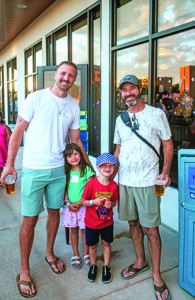
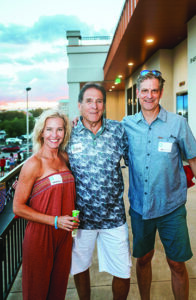
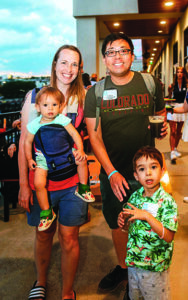
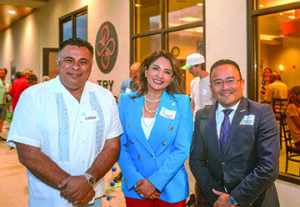

 On July 2, 2024, the Greater Glendale Chamber of Commerce hosted a private fireworks viewing party in the spectacular Try Club at Infinity Park. Nearly 275 guests converged on the facility to enjoy a true VIP experience.
On July 2, 2024, the Greater Glendale Chamber of Commerce hosted a private fireworks viewing party in the spectacular Try Club at Infinity Park. Nearly 275 guests converged on the facility to enjoy a true VIP experience.
For the third year in a row, the City of Glendale launched the fireworks from the South end of Infinity Park which, as Glendale City Manager Chuck Line calls it, a more intimate experience. The city capped attendance at 4,000 inside the stadium to allow for more room for guests to spread out and offer a relaxed atmosphere. An additional estimated 9,000 people viewed the show from the south park.
“The fireworks proximity to the people and playing the movie [Independence Day] beforehand enhanced the experience, and we foresee doing this for many years to come,” said Line. “Guests inside the park cheered when they destroyed the aliens in the movie and then 15 minutes later we blew off the fireworks. I loved that we were able to provide this for the community. It was a very patriotic  night.”
night.”
Line is already thinking about next year. “Next year will be even better and go to another level,” said Line. “We may allow more people into the stadium and a different movie will be played.”
While the fireworks are not blown as high in the sky as years past, the view from the field where spectators are allowed in with their own picnic, is spectacular. Line admits that viewing from surrounding neighborhoods has diminished but it makes for an easier setup and tear down. Managing the street closures and crowds is more expedited as well. Traffic was cleared after the show within 30 minutes. “Police and public works do a phenomenal job,” said Line. “A lot of preparation goes into this show and they executed flawlessly.”
As far as the private party for chamber members, they were treated to BBQ from Six Capital Brewing, bottomless popcorn courtesy of the Bull & Bush Brewery, a photo booth from Wild Pearl Photo Booth Co. sponsored by The Alchemy Group, lawn games on the terrace, and a prize wheel with many goodies from Chamber members.
for chamber members, they were treated to BBQ from Six Capital Brewing, bottomless popcorn courtesy of the Bull & Bush Brewery, a photo booth from Wild Pearl Photo Booth Co. sponsored by The Alchemy Group, lawn games on the terrace, and a prize wheel with many goodies from Chamber members.
Guests were also treated to bundt cakes from Nothing Bundt Cakes. “Nothing Bundt Cakes have been a strong supporter of our Chamber and the community at large throu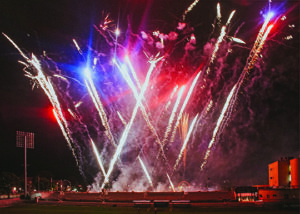 gh the years”, said Jeff Allen, COO, Greater Glendale Chamber of Commerce. “The bundt cakes were a wonderful addition to our already spectacular VIP party. An event I would say is one of the best ever in our 25 year history.”
gh the years”, said Jeff Allen, COO, Greater Glendale Chamber of Commerce. “The bundt cakes were a wonderful addition to our already spectacular VIP party. An event I would say is one of the best ever in our 25 year history.”
Chamber members had access to the air-conditioned Try Club and conference room and the entire concourse where they played cornhole, ladder toss, putt putt golf, networked while enjoying a libation from Scrum Enterprises, and, of course, watched the fireworks.
The Chamber has a long history of hosting fireworks parties for its members and this year’s event at the Try Club was one of the most memorable and the third year in a row in the Try Club courtesy of the City of Glendale. For more information about the Chamber or to join to ensure an invitation for next year, visit www.ggchamber.com.
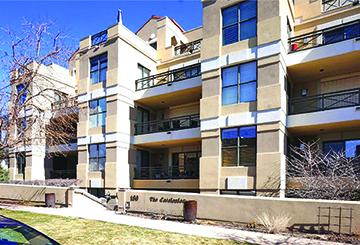
by Valley Gadfly | Jul 18, 2024 | Main Articles
Denver’s Business District Becoming Neighborhoods; Another 1,837 Apartments Planned In The Coming Year
by Glen Richardson
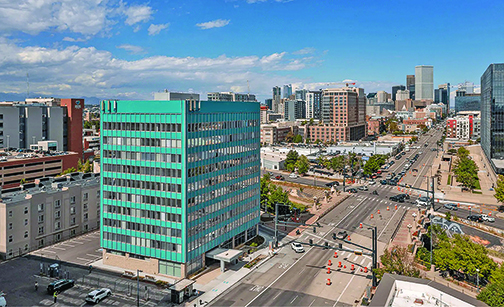
Best Of Broadway: This nine-story medical building was renovated into studio and one-bedroom apartments. Fourteen units are for unhoused patients released from Denver Health.
If you’ve noticed some old buildings getting a new lease on life in Denver, you’re right. The Mile High City ranks among the nation’s top spots for apartment conversions, with about 300 apartments entering the market through adaptive reuse in 2023 — and there are six times more such apartments on the horizon.
In addition to generating more apartments, the trend is likely to bring more people and energy to downtown Denver, hard hit by the pandemic’s work-from-home deluge. Residential conversions are anticipated to bring people and new energy to downtown apart from the workday. If so, stores, restaurants, entertainment, and other amenities of a vibrant lifestyle will optimistically return.
RentCafe’s annual adaptive reuse report shows that apartment conversions are on the rise again in the U.S., having increased by 18% in 2023 compared to the previous year. Plot twist: While office conversions are usually the go-to for future projects, hotel conversions rocked the charts in 2023, hitting a record high. Yet, with 58,000 office projects in various development stages nationwide, office conversions are expected to take the lead again.
Mile High Style
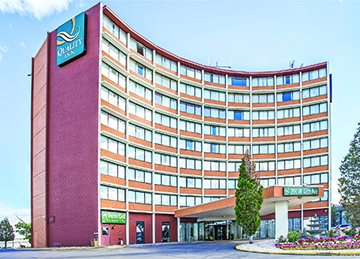
Clarion Converted: Renamed Renewal Village, the 215-room Clarion Hotel is the largest Mile High hotel converted to apartments to date.
Denver is part of the trend, with around 1,000 new units projected to be created through repurposing former office spaces.
Denver ranks 8th among cities with the most conversions in 2023. Developers successfully transformed a school building into 190 apartments, and a 1956 office building located at 655 Broadway is now home to 110 new apartments.
Looking ahead, The Mile High City is a major player in future apartment conversions, with plans to bring 1,837 new apartments to life in the coming year. Office conversions prevail (1,002 units), while repurposed schools (420 units) and hotel conversions (261 units) are also set to expand Denver’s rental market. The remaining units will come from residential conversions.
Metro Area Trend
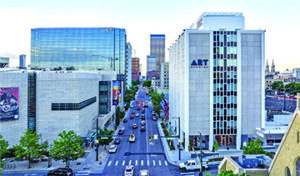
Street Art: The 10-story Art Institute building was converted into 192 apartments named Art Studios. Nichols Partnership was the hammer that shaped the new art piece.
In the Denver-Aurora-Lakewood metro area, office conversions are expected to be the most popular, mainly due to the 1,000 projected units in the capital city. Following closely are hotel conversions (937 units), including 576 apartments expected to be retrofitted in Aurora.
Adaptive reuse refers to the process of converting an existing building for purposes other than those it was originally designed for. In this article, adaptive reuse is expressed as the conversion of an existing building into rental apartments. The RentCafe study is based on apartment data related to buildings containing at least 50 units.
Data, of course, is subject to change. New properties and markets may emerge, while some properties might not be completed or maintain the same status (other than completed) for several years. Additionally, various factors such as delays, sales, or project abandonment can prevent completion of some properties. Future projects encompass those currently undergoing conversion, as well as those in the planning and prospective redevelopment stages.
Long Local History

Creek Condos: This office building on Cook St. in Cherry Creek was converted into 44 condos named Catalonian at Cherry Creek in the late 1990s.
Conversion of old buildings has a long history in Denver. Marcel Arsenault, founder and CEO of Real Capital Solutions, did his first office-to-residential conversion in Cherry Creek in the late 1990s. The building’s offices were converted to 44 condos, now named Catalonian at Cherry Creek at 180 Cook Street. It was an old office building, and so the price was low. At the same time Cherry Creek residential values were high. Everybody wants to live in Cherry Creek; thus, it made sense for Arsenault to do residential
In 2006, 1600 Glenarm Place, a 31-story tower at 16th Street Mall, was turned into more than 300 units. In 2015 Nichols Partnership converted the former Hotel VQ next to Bronco’s stadium into Turntable Studios, a 13-story complex with 179 studio apartments. In 2022, the owner of Denver’s Petroleum Building filed plans to turn the office building into around 130 apartment units.
Nichols Partnership completed the 10-story, 192 apartment Art Studios — the former Art Institute of Colorado building — in the first quarter of 2023. Located in Denver’s Golden Triangle neighborhood, conversion of the building acquired in 2019 was delayed by the pandemic. Using leftover materials for the school, the rebuild honors the building’s history. Nichols Partnership also converted the five-story One Platte office building, at 1701 Platte St. Completed in the spring 2022, it’s now 90% leased, a testament to both the building and the Platte St. location.
Hotel Renovations
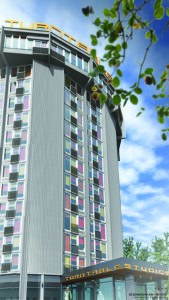
Turntable Trend: In 2015 the former Hotel VQ next to Bronco’s stadium was converted into Turntable Studios, a 13-story complex with 179 apartments.
Denver’s hotel conversions have virtually all been for the city’s homeless plus the migrant invasion. The earliest was in February, 2020 when a former Quality Inn & Suites on Quebec Street in Park Hill was converted into apartments known as Fusion Studios. The changeover provided transitional and long-term housing. At that time, the city required residents to pay up to 30% of their monthly income as rent.
With a new mayor and city council, Denver has been purchasing hotel housing — albeit mostly older properties and most often motels — at a record-setting pace. The tempo has been so fast neither the media nor citizens can keep pace. Here’s a sampling: New Directions, a former Best Western in the 4500 block of N. Quebec St. The city paid $25.95 million for the 194-unit property; Tamarac Family Shelter, previously an Embassy Suites on East Hampden Ave., Denver paid a combined $30.9 million for lease-purchase; Clarion Hotel is Denver’s largest to be converted to housing for the homeless. Renamed Renewal Village, the 215-room hotel was purchased in Jan. 2023 for $24 million — $10 million each from Denver and the Colorado Division of Housing, plus $3.6 million from Adams County.
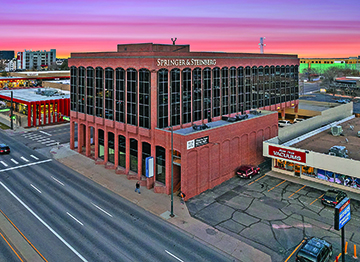
by Mark Smiley | Jun 20, 2024 | Main Articles
Contingency Fee For Catastrophic Injury Is A Growing Segment Of Its Practice
by Mark Smiley
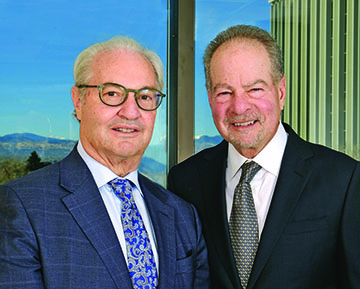
Partners: Jeff Springer (right) and Harvey Steinberg started the Law firm of Springer & Steinberg over 40 years ago.
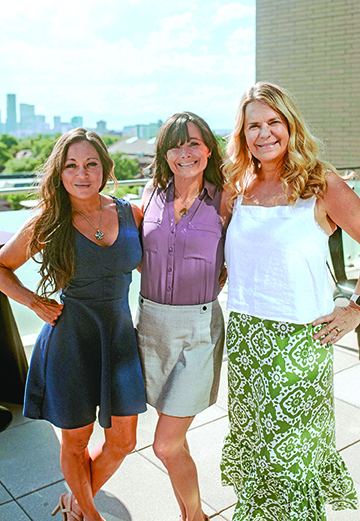
Networking: Cielo Busch, Director of Legal Administration & Marketing for Springer & Steinberg (left), Megan Stephens, Colorado Athletic Club (middle), and Debbie Fitzgerald, Partner/Co-Founder at Fitzgerald Peterson, were among the attendees at the latest Business After Hours for the Glendale Chamber.
Springer & Steinberg is a law firm that started over 40 years ago and has spent most of its existence with offices in downtown Denver. Last year, the firm moved to an office building close to I-25 and Colorado Blvd., and after 11 months of permitting and construction, in June 2024 its new space is finished on the top floor of the building.
“Downtown has advantages when you’re a lawyer because you can be close to all the courthouses,” said Jeff Springer, partner at Springer & Steinberg. “It was great when I was a younger lawyer. The opportunity to be right next door to Glendale, even though we couldn’t find the right arrangement for us in Glendale, was attractive.”
Springer eluded to the difficulty of maneuvering downtown and hassling with parking as a reason potential clients would shy away from retaining their services. “Where we are now, you can get here and park, and you can easily maneuver through traffic,” said Springer. ”It is much more convenient.”

New Office: Springer & Steinberg moved from downtown to South Colorado Blvd. last year and moved into its new office space in June 2024. The firm is more conveniently located for potential clients.
Even though the firm is not technically in Glendale, Springer considers the firm a part of Glendale based on where they are
situated. “We have the benefits of Glendale and we get to visit everybody in Glendale, we get to the rugby pitch, and the event center,” said Springer. “For everybody in the firm, it is a real advantage. The location is terrific along with the views and access. We are very excited.”
Although close to Glendale, Springer felt the effects of not being within the city boundaries. “If we were in Glendale, we would have moved into this space six months ago. But, in Denver, you can’t get them to act and approve permits. It takes forever to get things done.”
Glendale has a reputation for being efficient and consumer and business friendly. “If you are deserving of one, you can get a permit in Glendale very quickly,” said Springer. “They want to make sure they get things built and built on time. For whatever reason, in Denver, it doesn’t work that way.”
Since it started over 40 years ago, the law firm of Springer & Steinberg has broadened its skillset. Their lawyers can handle every kind of litigation imaginable such as criminal, personal injury, landlord tenant, construction, corporate, trademark, and copyright.
A rapidly growing aspect of the firm’s practice is contingency fee work for catastrophic injuries including serious automobile accidents. They also do transactional work. The firm has transactional lawyers who can form entities and corporations, handle wills and trusts, and probate. Springer & Steinberg can provide a full service because of the depth and breadth of the lawyers on staff. They are all experienced and skilled lawyers. “We don’t typically take lawyers right out of law school,” said Springer. “We want to see them get some experience and seasoning.”
Springer & Steinberg can provide people with full service and be their lawyer and also be a company’s lawyer. “If we represent a company, we can do everything from A to Z,” said Springer. “We can form them and help them when they operate. We can defend them in litigation, and pursue litigation on their behalf. And it’s the same thing for individuals. We can take care of families and oftentimes do.”
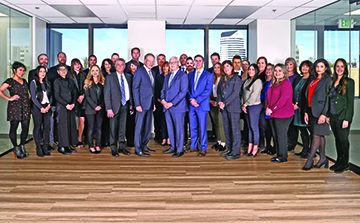
Experience: The Law firm of Springer & Steinberg has a fleet of experienced attorneys specializing in many different areas.
Springer & Steinberg has been known to take on unpopular cases as well. “My partner, Harver Steinberg, does a number of cases that are important from a constitutional standpoint, and yet some of the people we represent are not well received by parts of the community,” said Springer. “Yet, we have a duty to do good for everybody. The people on the top of the totem pole as well as the people on the bottom of the totem pole. That’s what we try to do.”
In addition, Springer & Steinberg has been the city attorneys for Glendale for over 20 years. “I have seen the city grow and develop from every perspective,” said Springer. “What the city does for its citizens and what it does for the people nearby and surrounding areas is absolutely incredible. The opportunities that one has in Glendale for entertainment, exercise, events, scenery, activities, is unmatched in my estimation.”
Springer adds that Glendale is a shining light in the metro area. “It is a tribute to all of the hard-working people in Glendale and its citizens who take an active role in what goes on in Glendale,” said Springer. He attributes much of Glendale’s success to its current Mayor, Mike Dunafon. “Mayor Dunafon is a true visionary,” said Springer. “He had a true vision of what Glendale could be. Through his hard work and efforts, he has made it happen.”
For more information on the firm or to schedule a consultation visit www.springersteinberg.com, or call 303-861-2800.
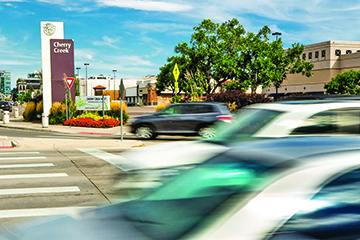
by Mark Smiley | Jun 20, 2024 | Main Articles
Largest Creek Development In History Set To Begin; To Cut Traffic, Slash Structure Size, Use, And Heights
by Wayne New & David Steel
Wayne New is a former Denver City Councilman. David Steel is the former CEO of Western Development.

Traffic Terror: 1st Ave., University, Steele, and Cherry Creek South Drive already have terrible traffic. Cherry Creek West project will add 10,000 vehicles per day.
Have you recently driven down Alameda, University, Steele, 1st Ave., or Cherry Creek South Drive and experienced the incredible traffic and congestion in the Cherry Creek area? Have you tried to cross 1st Ave. and feared that you could be hit by a car? You are not alone.
We believe in smart, well-designed development, but we all know that the unintended consequence of too much density without concurrent transportation planning is uncontrolled traffic. However, a Denver Moves Cherry Creek statement from City Planning and the Department of Transportation & Infrastructure reads: “DMCC recommends that an increase in density in Cherry Creek is needed to support higher frequency/more reliable transit, and allow for more local trips within Cherry Creek to be taken by walking/bicycling.”
They are putting the cart before the horse!
Choking Cherry Creek
What’s driving this large increase in Cherry Creek traffic? The problem begins with the Cherry Creek North Business Improvement District’s (BID) 10-year, 150% density growth plan.
Additional causes are:
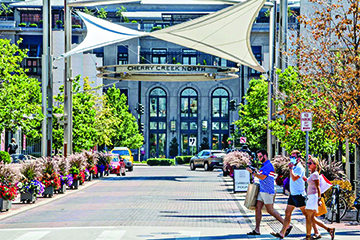
Safe Cross Streets: Major Cherry Creek North arterial streets — particularly 1st Ave. — have scarcity of safe pedestrian crossings despite shopping popularity.
- Underutilized BID underground parking and limited on-street parking is creating parking and traffic problems in the neighborhoods;
- Increased Leetsdale/Colorado cut through traffic on 1st Ave. to downtown. At least 50% of 1st. Ave. traffic is from cars originating from Leetsdale, Colorado Blvd., and University;
- Reduced RTD bus services/limited routes — limited service reduces employee transportation;
- Lack of planned transit implementation on major arterial corridors — the 2012 Cherry Creek Area Plan stated “Cherry Creek has highest regional traffic volume” and called for transit services. The City has estimated that it will take 10 to 20 years to implement transit;
- Limited use of City transportation demand management strategies to reduce traffic — City strategies to reduce traffic have not been emphasized or enforced;
- Maximum Intersection Capacities — 10 of the 13 major Cherry Creek area intersections exceed the maximum traffic of 36,000 cars per day.
Adding Obstacles
Even with all of the above, the City will be allowing the rezoning of the largest development in Cherry Creek history. This Cherry Creek West Project development on the west side of the Cherry Creek Shopping Center poses the following issues which will have to be addressed:
- Scale: The approximate 1,600,000-sq. ft. (SF) development will be 45% greater in SF compared to the present Shopping Center;
- Building Height: Three (3) of the seven (7) buildings will be 13 stories in height and one building will be 11 stories. The average height of all buildings will be 10.5 stories;
- Vehicle Traffic: According to the developer, the number of vehicle trips onto 1st Ave. and University will increase traffic by 1,000 vehicle trips per PM Peak Hour or 10,000 per day;
- Traffic Flow: The flow of traffic will be difficult with the property having only four (4) entrances/exits that are: two (2) one-way only and 2 two-way with lights. The existing Shopping Center, which is 45% smaller, has seven (7) entrances/exits with four (4) two-way with lights;
- Construction Difficulties: The entire 13-acre property will require two (2) to three (3) story-depth underground for project infrastructure construction and parking. Those 10 years of project construction will create continuous 1st Ave. traffic issues.
What To Do Now
What can immediately be done to reduce traffic, since transit is 10 to 20 years in the future?
Establish a 75% residential use ratio for new development for next five years since residential construction creates the lowest level of new vehicle trips; Expand RTD route services to Cherry Creek; Implement specific Transportation Demand Management measures for all existing and new building developments, which will have the potential of reducing Cherry Creek traffic by 2,500 vehicle trips per PM Hour:
More: a) Require RTD Eco-Pass programs to increase bus usage; b) Require hourly parking or unbundled parking for all building users, including employees; c) Implement bicycle support amenities for all buildings.
Structure Size, Height
Implement and fund shuttle services from Cherry Creek to University / I-25, the Colorado Blvd / I-25, and Colorado / I-70 light rail stations to expedite service to the present transit network.
Propose to the City a Development Impact Fee Program to help fund Cherry Creek improvements — a plan which has created millions of dollars from developers in other cities.
Even with these Cherry Creek options and recommendations, the easiest and most effective solution for immediate traffic reduction is to address new building use, size, and heights. Therefore, reducing the total CCW new development square feet and height to eight (8) stories will have a significant reduction in vehicle trips.
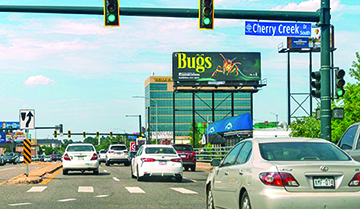
Crosstown Bugs: Cherry Creek Dr. South has become a major thoroughfare for drivers crossing in either direction between University Ave. and Colorado Blvd.
Resident Support
What can residents do to help? Implementation of any of these recommendations falls under the purview of the various registered neighborhood organizations (RNO) and their respective Councilperson.
Each RNO should send a Position Statement to the City & County of Denver (Councilperson). If a Position Statement is not sent, then, in effect, the RNO is endorsing the CCW Project as submitted. Written resident comments can also be sent to your Councilperson.
All concerned organizations and residents should attend Planning Board and the City Council meetings to express their opinions. Approval of the submitted CCW rezoning will create traffic and congestion for the foreseeable future. RNOs and business organizations are the ones with the stature to make a formal submittal of objection.
About The Authors
If you have questions, please contact Wayne New at wayneindenver@gmail.com or David Steel at steelyard@msn.com.

by Mark Smiley | Jun 20, 2024 | Main Articles
by Mark Smiley

Connecting: Two Pals & A Pup has had good traffic during the first month of the Glendale Farmers Market. They have also made good connections with other vendors. Visit www.twopalsandapup.com for more information.

Saucy: Saucy Chops Food Truck is a Colorado born Food Truck that provides everyone’s classic favorites such as a chicken parmesan sandwich doused with scratch made sauces. Visit www.saucychops5280.com for more information.

Inaugural Year: The new Glendale Farmers Market has attracted a crowd of enthusiasts each weekend and it will run every Saturday through August 31, 2024.
The Hispanic Restaurant Association, in cooperation with the City of Glendale and the Greater Glendale Chamber of Commerce, started a farmers market in Glendale and the first month was a huge hit.
The farmers market is located at 4601 E. Kentucky Avenue in Glendale (the P1 parking lot near Infinity Park). It runs every Saturday through August 31 from 8 a.m. to 1 p.m. The market is touted as an experiential farmers market, catered by the Hispanic Restaurant Association’s own chefs and different from the usual farmers markets around the area.

Hot Sauce: Mamas Peri Peri Hot Sauce is one of the vendors at the Glendale Farmers Market each Saturday. The sauce is an ancient family recipe carefully blended in a time-honored tradition of Portuguese culinary excellence. Learn more at www.mamasperiperi.com.
“The Glendale Farmers Market is fabulous,” said Kim Umbarger, Glendale City Councilmember. “It has a lot of variety. I am a farmers market enthusiast so I was expecting it to be tiny. But it had all the things. You have all of the really good produce, fruits, and there were games for my kids which I was not expecting. And there was music. I didn’t realize but the hill is shaded so you can sit on the grass and eat your snacks. I highly recommend it. It is a great market.”
The Glendale Farmers Market features multiple chef demonstrations, a Taylor Swift booth for the kids to dance, plenty of locally sourced sauces, vegetables, and more. The vendors are also pleased with the Saturday market. “We are pleased to be part of this farmers market in its inaugural year,” said Stacey Bennett, co-owner of Two Pals & A Pup. “We have had good traffic at our booth each weekend and we are appreciative for the opportunity the Glendale Chamber and the Hispanic Restaurant Association provided us. We look forward to the rest of the summer.”
Since USDA’s Agricultural Marketing Service began tracking farmers’ markets in 1994, the number of markets in the United States has grown to 8,720, an increase of about 7.07 percent from 2013. Total annual sales at U.S. farmers’ markets are estimated at $1 billion. On an average market day, 916 households shopped across markets in the U.S. and spent $14,547 per farmers market. The Hispanic Restaurant Association is well positioned to make the Glendale Farmers Market one of the most popular and unique in the Cherry Creek Valley.
Visit www.glendalefarmersmarket.com for more information and to explore the vendors lined up for the summer.

by Jessica Hughes | May 20, 2024 | Main Articles
by Jessica Hughes

The Hispanic Restaurant Association, or HRA, will be hosting its first farmers market in the parking lot of Infinity Park in Glendale on Saturdays starting May 25.
What better way to savor summer in the Cherry Creek Valley area than by visiting a local farmers market? The thriving farmers market scene has become a beloved summer tradition for locals and visitors alike. With an abundance of markets scattered throughout the area, these organic gatherings offer a unique opportunity to connect with local producers, savor the flavors of the region, and immerse oneself in the community.
A primary reason for the popularity of farmers markets is the access they provide to fresh, locally grown produce. Colorado’s rich agricultural heritage and diverse microclimates allow for a wide variety of fruits and vegetables to flourish, from juicy cherries and peaches in Palisade to crisp corn from Olathe and sweet melons from Rocky Ford. By purchasing directly from the farmers, consumers can not only enjoy the fresh taste and nutritional value of these harvested goods but also support the local economy and sustainable farming practices.
Beyond the abundance of produce, farmers markets offer a unique shopping experience that caters to a variety of tastes and interests. Artisanal baked goods, locally raised meats, handcrafted goods, and even fashion trucks and pop-up boutiques can be found at many
of these markets, creating a one-stop-shop for those seeking a curated and authentic shopping experience.
From the long-running Metro Denver Farmers’ Market, which has been operating for over 40 years, to newer additions like the People + Produce at Belleview Station and the Glendale Farmers Market, these events have become integral parts of the community fabric.
Moreover, these markets provide a platform for local chefs and culinary enthusiasts to showcase their talents. Many markets feature chef demonstrations, interactive cooking classes, and on-site food trucks, offering visitors a chance to learn from the experts and sample the flavors of the region transformed into delicious dishes.
Mark your calendars and prepare to fill your reusable bags at these can’t-miss farmers markets.
Glendale Farmers Market
When: Saturdays, May 25 – August 31,
8 a.m. – 1 p.m.
Where: Infinity Park, 4601 E Kentucky Ave., Glendale
New this year, discover Colorado’s vibrant culinary scene at the Glendale Farmers Market. In partnership with the Hispanic Restaurant Association, the City of Glendale, and the Greater Glendale Chamber of Commerce, this flavorful market features a unique fusion of locally sourced agriculture and culinary excellence. Discover fresh, locally grown fruits, vegetables, and meats alongside Chef Pablo’s Kitchen and an interactive Chef’s Table, where you can savor the bounty of Colorado transformed into exquisite dishes.
Colorado Fresh Markets (Cherry Creek)
When: Saturdays, May 4 – Oct. 12, 2024, 9 a.m. – 2 p.m.
Where: New this year, the market is on the east side of Cherry Creek Shopping Center, along South Steele Street near Macy’s
Located in the heart of Denver’s Cherry Creek neighborhood, the Colorado Fresh Markets mixes both fashion and farms. With local vendors selling homegrown produce and goods, plus fashion trucks and pop-up boutiques, it’s the perfect chance to stock up on seasonal fruits and veggies, plus the latest in fashion trends. Enjoy free parking when you get your ticket validated at the market. coloradofreshmarkets.com.
Urban Market at Denver Union Station
When: Five summer weekends starting June 1 – August 18, 2024, 12 – 6 p.m.
Where: Denver Union Station
(1701 Wynkoop St, Denver, CO 80202)
Spend your summer weekends in the heart of downtown Denver at the Urban Market, in Denver Union Station. Less of a farmers market and more of an artisan market, shoppers will find local arts and crafts sold directly by the artists, clothing, jewelry, antiques, and furniture, with some local produce mixed throughout.
Metro Denver Farmers Market
When: Saturdays, May 4 – Oct. 26, 2024,
8 a.m. – 2 p.m.
Where: The southeast parking lot at
Wadsworth Boulevard and
West Bowles Avenue, Littleton
What began over 40 years ago as a small market in downtown Denver in an Auraria campus parking lot, the Metro Denver Farmers Market is now Denver’s longest-running market and a favorite for shopping the freshest, local foods. Each week over 30 vendors offer a mix of produce from local generational farms, prepared foods from local food makers, and craft vendors.
City Park Esplanade Fresh Market
 When: Saturdays, May 4 – Oct. 26, 2024,
When: Saturdays, May 4 – Oct. 26, 2024,
from 8 a.m. – 1 p.m.
Where: 2551 E Colfax Ave., Denver
Working with local farmers and growers, the City Park Farmers Market recaptures the tradition of selling local produce and goods that are good for you and the economy. The family-friendly market brings live entertainment and a festive vibe all while enjoying breakfast, lunch, and brunch-prepared food options. Plus, with monthly chef demos by some of Denver’s favorite chefs, you’ll never run out of at-home meal ideas. cityparkfarmersmarket.com.
South Pearl Street Farmers Market
When: Sundays, May 5 – Nov. 10, 2024,
9 a.m. – 1 p.m.
Where: South Pearl Street, between Arkansas and Iowa, in Denver
The South Pearl Street Farmers Market sets up shop along the quaint South Pearl Street — home to Denver food favorites; Kaos Pizzeria and Sushi Den. Every Sunday from May to November, the street (between the 1400 and 1500 blocks) becomes an eclectic mix of local produce stands, handmade goods crafted by local artisans, food trucks, and live music for the entire family. southpearlstreet.com
 University Hills Farmers Market
University Hills Farmers Market
When: Saturdays, May 11 – Oct. 26, 2024,
9 a.m. – 1 p.m.
Where: University Hills Plaza,
2500 S. Colorado Blvd.
While smaller in size, the University Hills Farmers Market offers plenty of fresh finds and free parking for its shoppers. A prime shopping location in Denver since 1955, the University Hills Plaza hosts the weekly market featuring a variety of local produce, handmade goods, flowers and more. uhpla za.com.
 Highlands Square Farmers Market
Highlands Square Farmers Market
When: Sundays, May 19 – Oct. 13, 2024,
9 a.m. – 1 p.m.
Where: 32nd Ave & Lowell Blvd, Denver
The Highlands Square Farmers Market, one of Denver’s newest markets, offers a trendy twist with its market bar. Shoppers can enjoy a crafty concoction while shopping Colorado-grown produce, flowers, baked goods, and a variety of ready-to-eat foods, all while vibing to the sound of live music. highlandssquarefarmersmarket.com.
People + Produce at Belleview Station
When: Sundays, June 2 – Oct. 13, 2024,
9 a.m. – 1:30 p.m.
Where: Belleview Station, at the corner of I-25 and East Belleview Avenue, DTC
The People + Produce market is Denver’s newest farmers market serving Southeast Denver, Cherry Hills Village, Greenwood Village, and the DTC. The market will feature 50+ vendors each week, selling everything from farm fresh produce and baked goods to locally crafted artisan goods. Plus, with food trucks, fashion trucks, live music and a beer garden, it’s sure to be a fun time. Peopleandproducebvs.com.
Farmers markets are a great place to find fresh, locally sourced foods from Colorado farmers.
In addition to locally grown produce, many farmers markets sell other items such as fresh flowers.
City Park Farmers Market photos
The Cherry Creek Valley is home to a variety of farmers markets throughout the city.












 On July 2, 2024, the Greater Glendale Chamber of Commerce hosted a private fireworks viewing party in the spectacular Try Club at Infinity Park. Nearly 275 guests converged on the facility to enjoy a true VIP experience.
On July 2, 2024, the Greater Glendale Chamber of Commerce hosted a private fireworks viewing party in the spectacular Try Club at Infinity Park. Nearly 275 guests converged on the facility to enjoy a true VIP experience. night.”
night.” for chamber members, they were treated to BBQ from Six Capital Brewing, bottomless popcorn courtesy of the Bull & Bush Brewery, a photo booth from Wild Pearl Photo Booth Co. sponsored by The Alchemy Group, lawn games on the terrace, and a prize wheel with many goodies from Chamber members.
for chamber members, they were treated to BBQ from Six Capital Brewing, bottomless popcorn courtesy of the Bull & Bush Brewery, a photo booth from Wild Pearl Photo Booth Co. sponsored by The Alchemy Group, lawn games on the terrace, and a prize wheel with many goodies from Chamber members. gh the years”, said Jeff Allen, COO, Greater Glendale Chamber of Commerce. “The bundt cakes were a wonderful addition to our already spectacular VIP party. An event I would say is one of the best ever in our 25 year history.”
gh the years”, said Jeff Allen, COO, Greater Glendale Chamber of Commerce. “The bundt cakes were a wonderful addition to our already spectacular VIP party. An event I would say is one of the best ever in our 25 year history.”




















